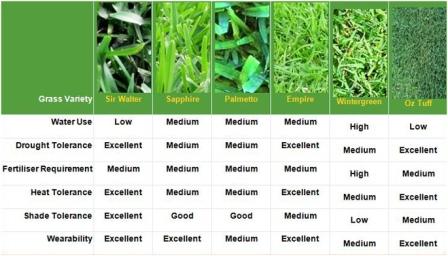Shadow grasses
Kentucky bluegrass, tall fescue ((Festuca arundinacea L.) and ryegrass are widely used in orchards. They can relatively well against trampling and fungal diseases.
Red fescue and wood bluegrass ((Poa nemoralis) tolerate much tree shade. Common bent grass (Agrostis capillaries) and velvet bentgras (Agrostis canina L.) less.
In dense (and humid) shadow of buildings rough bluegrass (Poa trivialis L.) and annual bluegrass (Poa annua L.) still thrive.
 For nutrient-poor, dry or variable dry sandy soils
For nutrient-poor, dry or variable dry sandy soils
Sweet vernal grass (Anthoxanthum odoratum)
Big Quaking Grass (Briza media)
Wavy hairgrass (Deschampsia flexuosa)
Sheep Grass (Festuca ovina)
Red fescue (Festuca rubra)
Purple Moor Grass (Molinia caerul)
For moderately rich, dry soils (not on clay)
Sweet Vernal Grass (Anthoxanthum odoratum)
Crested dog's tail (Cynosurus cristatus)
Orchardgrass (Dactylis glomerata)
Red fescue (Festuca rubra)
Fine fescue (Festuca tenuif)
For moderately rich, moist to wet soils, even for river alluvia
Meadow fescue (Festuca pratensis)
Ryegrass (Lolium perenne)
Kentucky bluegrass (Poa pratensis)
Rough blue grass (Poa trivialis)
Wet soil
Marsh(or water-) Foxtail (Alopecurus geniculatus)
Rushes (Juncus)
For dry, calcareous soils
Crested dog's tail (Cynosurus cristatus)
Orchardgrass (Dactylis glomerata)
Prairie Junegrass (Koeleria macrantha)
Boehmer's cats-tail (Phleum phleoides)
Blue Moor Grass (Sesleria caerulea)
A trampling tolerant plant is a plant which grows in places with a lot of foot traffic and thus have little oxygen and a compacted bottom. Many of those plants have (lateral creeping) branching or tillering near the ground, a quick recovering ability and elastic capacity while firm tissue.
For compacted soils
Annual blue Grass (Poa annua)
(Common) knotgrass (Polygonum aviculare)
Ryegrass (Lolium perenne)
Little love grass (Eragrostis minor)
Hand Grass (Cynodon dactylon) Bermuda grass
White clover (Trifolium repens)
Greater (or broadleaf) plantain (Plantago major)
Daisy (Bellis perennis)
Ger Londo (Wageningen) experimented with grassland which he mowed once or twice a year and drained the clippings. By said discharge, and the lack of fertilization the ground withered. After three years bent grass (Agrostis tenuis) and rough bluegrass (Poa trivialis) species were dominant. After nine years these species were marginal. Their position was taken over by common bent grass (Agrostis capillaries) and sweet vernal grass (Anthoxanthum odoratum). Also germander speedwell (Veronica chamaedrys) and ribwort plantain (Plantago lanceolata) came after years in a pasture. Londo attributes this shift to the open ground initially slams through the rain. This effect is only over time set off by the vegetation.
The evolution of heavily fertilized intensively cultivated grassland farming in semi-natural grasslands occurs over a six - phases
|
Fase |
Production phase |
Type Quantity (per 25m²) |
|
0: ryegrass pasture |
>10 |
5-10 highly poor of species |
|
1: grass mixture |
8 -10 |
10-15 poor of species |
|
2: dominant phase |
6 – 8 |
10 – 15 species-poor |
|
3: grass – herbs mix |
5 – 7 |
15 – 25 moderately species rich |
|
4: flowery grassland |
3 – 6 |
20 – 40 species rich |
|
5: barren land |
<5 |
>30 species rich |
Grass seeds need light to germinate. The seed should not be (too much) covered.
